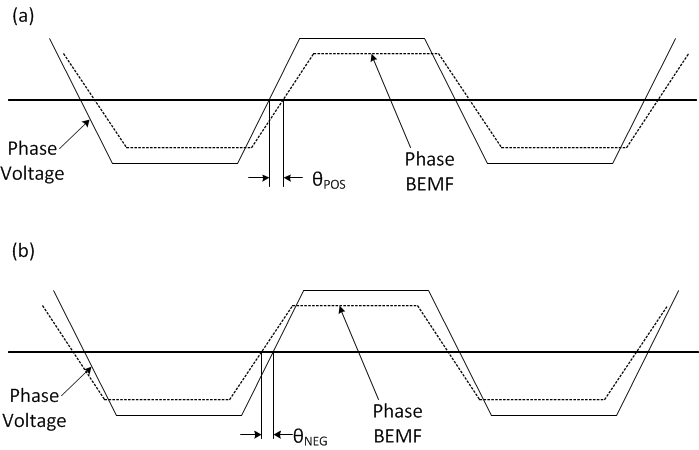SLLSFQ3 January 2023 MCT8329A
PRODUCTION DATA
- 1 Features
- 2 Applications
- 3 Description
- 4 Revision History
- 5 Pin Configuration and Functions
- 6 Specifications
-
7 Detailed Description
- 7.1 Overview
- 7.2 Functional Block Diagram
- 7.3
Feature Description
- 7.3.1 Three Phase BLDC Gate Drivers
- 7.3.2 Gate Drive Architecture
- 7.3.3 AVDD Linear Voltage Regulator
- 7.3.4 DVDD Voltage Regulator
- 7.3.5 Low-Side Current Sense Amplifier
- 7.3.6 Device Interface Modes
- 7.3.7 Motor Control Input Options
- 7.3.8 Starting the Motor Under Different Initial Conditions
- 7.3.9 Motor Start Sequence (MSS)
- 7.3.10 Closed Loop Operation
- 7.3.11 Speed Loop
- 7.3.12 Power Loop
- 7.3.13 Anti-Voltage Surge (AVS)
- 7.3.14 Output PWM Switching Frequency
- 7.3.15 Fast Start-up (< 50 ms)
- 7.3.16 Fast Deceleration
- 7.3.17 Dynamic Voltage Scaling
- 7.3.18 Motor Stop Options
- 7.3.19 FG Configuration
- 7.3.20
Protections
- 7.3.20.1 PVDD Supply Undervoltage Lockout (PVDD_UV)
- 7.3.20.2 AVDD Power on Reset (AVDD_POR)
- 7.3.20.3 GVDD Undervoltage Lockout (GVDD_UV)
- 7.3.20.4 BST Undervoltage Lockout (BST_UV)
- 7.3.20.5 MOSFET VDS Overcurrent Protection (VDS_OCP)
- 7.3.20.6 VSENSE Overcurrent Protection (SEN_OCP)
- 7.3.20.7 Thermal Shutdown (OTSD)
- 7.3.20.8
Cycle-by-Cycle (CBC) Current Limit (CBC_ILIMIT)
- 7.3.20.8.1 CBC_ILIMIT Automatic Recovery next PWM Cycle (CBC_ILIMIT_MODE = 000xb)
- 7.3.20.8.2 CBC_ILIMIT Automatic Recovery Threshold Based (CBC_ILIMIT_MODE = 001xb)
- 7.3.20.8.3 CBC_ILIMIT Automatic Recovery after 'n' PWM Cycles (CBC_ILIMIT_MODE = 010xb)
- 7.3.20.8.4 CBC_ILIMIT Report Only (CBC_ILIMIT_MODE = 0110b)
- 7.3.20.8.5 CBC_ILIMIT Disabled (CBC_ILIMIT_MODE = 0111b or 1xxxb)
- 7.3.20.9 Lock Detection Current Limit (LOCK_ILIMIT)
- 7.3.20.10 Motor Lock (MTR_LCK)
- 7.3.20.11 Motor Lock Detection
- 7.3.20.12 IPD Faults
- 7.4 Device Functional Modes
- 7.5 External Interface
- 7.6 EEPROM access and I2C interface
- 7.7 EEPROM (Non-Volatile) Register Map
- 7.8 RAM (Volatile) Register Map
-
8 Application and Implementation
- 8.1 Application Information
- 8.2
Typical Applications
- Detailed Design Procedure
- Bootstrap Capacitor and GVDD Capacitor Selection
- 8.2.1 Selection of External MOSFET for VREG Power Supply
- Gate Drive Current
- Gate Resistor Selection
- System Considerations in High Power Designs
- Capacitor Voltage Ratings
- External Power Stage Components
- 8.2.2 Application curves
- 9 Power Supply Recommendations
- 10Layout
- 11Device and Documentation Support
- 12Mechanical, Packaging, and Orderable Information
Package Options
Mechanical Data (Package|Pins)
- REE|36
Thermal pad, mechanical data (Package|Pins)
Orderable Information
7.3.10.3 Lead Angle Control
To achieve the best efficiency, it is often desirable to control the drive state of the motor so that the motor phase current is aligned with the motor BEMF voltage. MCT8329A provides the option to advance or delay the phase voltage from the commutation point by adjusting the lead angle. The lead angle can be adjusted to obtain optimal efficiency. This can be accomplished by operating the motor at constant speed and load conditions and adjusting the lead angle (LD_ANGLE) until the minimum current is achieved. The MCT8329A has the capability to apply both positive and negative lead angle (by configuring LD_ANGLE_POLARITY) as shown in #SLVSCP25471
Lead angle can be calculated by {LD_ANGLE x 0.12}o; for example, if the LD_ANGLE is 0x1E and LD_ANGLE_POLARITY is 1b, then a lead angle of +3.6o(advance) is applied. If LD_ANGLE_POLARITY is 0b, then a lead angle of -3.6o(delay) is applied.
For 120o commutation, the negative lead angle is limited to -20o; any lead angle lower than that will be clamped to -20o.
For variable commutation, negative lead angle is not supported and positive lead angle is limited to +15o. Anything configured higher than +15o or lower than 00 will be clamped to 15o and 0o respectively.
 Figure 7-26 Positive and Negative Lead Angle Definition
Figure 7-26 Positive and Negative Lead Angle Definition